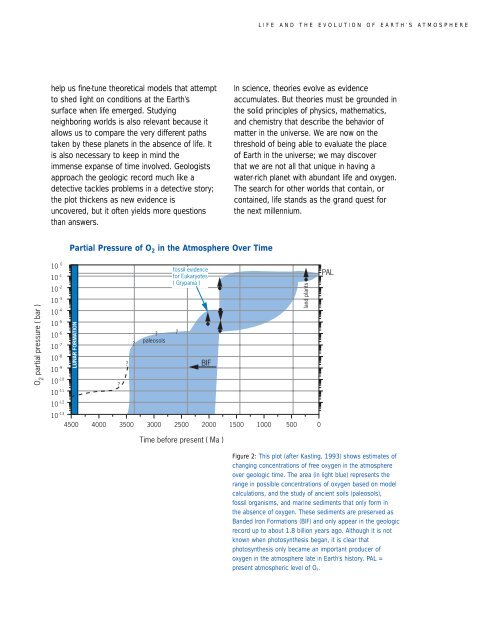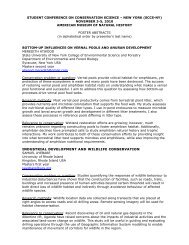"Life and the Evolution of Earth's Atmosphere." Earth
"Life and the Evolution of Earth's Atmosphere." Earth
"Life and the Evolution of Earth's Atmosphere." Earth
- No tags were found...
You also want an ePaper? Increase the reach of your titles
YUMPU automatically turns print PDFs into web optimized ePapers that Google loves.
LIFE AND THE EVOLUTION OF EARTH’S ATMOSPHEREhelp us fine-tune <strong>the</strong>oretical models that attemptto shed light on conditions at <strong>the</strong> <strong>Earth</strong>’ssurface when life emerged. Studyingneighboring worlds is also relevant because itallows us to compare <strong>the</strong> very different pathstaken by <strong>the</strong>se planets in <strong>the</strong> absence <strong>of</strong> life. Itis also necessary to keep in mind <strong>the</strong>immense expanse <strong>of</strong> time involved. Geologistsapproach <strong>the</strong> geologic record much like adetective tackles problems in a detective story;<strong>the</strong> plot thickens as new evidence isuncovered, but it <strong>of</strong>ten yields more questionsthan answers.In science, <strong>the</strong>ories evolve as evidenceaccumulates. But <strong>the</strong>ories must be grounded in<strong>the</strong> solid principles <strong>of</strong> physics, ma<strong>the</strong>matics,<strong>and</strong> chemistry that describe <strong>the</strong> behavior <strong>of</strong>matter in <strong>the</strong> universe. We are now on <strong>the</strong>threshold <strong>of</strong> being able to evaluate <strong>the</strong> place<strong>of</strong> <strong>Earth</strong> in <strong>the</strong> universe; we may discoverthat we are not all that unique in having awater-rich planet with abundant life <strong>and</strong> oxygen.The search for o<strong>the</strong>r worlds that contain, orcontained, life st<strong>and</strong>s as <strong>the</strong> gr<strong>and</strong> quest for<strong>the</strong> next millennium.Partial Pressure Pressure <strong>of</strong> O 2 <strong>of</strong> in O<strong>the</strong> 2 in <strong>Atmosphere</strong>s <strong>the</strong> OvertimeTimeO 2partial pressure ( bar )10 010 -210 -310 -410 -510 -610 -710 -8LUNAR FORMATION?10 -910 -10?10 -1110 -1210 -13?? ?paleosolsfossil evidencefor Eukaryotes( Grypania )BIFl<strong>and</strong> plantsPAL10 -1 4500 4000 3500 3000 2500 2000 1500 1000 500 0Time before present ( Ma )Figure 2: This plot (after Kasting, 1993) shows estimates <strong>of</strong>changing concentrations <strong>of</strong> free oxygen in <strong>the</strong> atmosphereover geologic time. The area (in light blue) represents <strong>the</strong>range in possible concentrations <strong>of</strong> oxygen based on modelcalculations, <strong>and</strong> <strong>the</strong> study <strong>of</strong> ancient soils (paleosols),fossil organisms, <strong>and</strong> marine sediments that only form in<strong>the</strong> absence <strong>of</strong> oxygen. These sediments are preserved asB<strong>and</strong>ed Iron Formations (BIF) <strong>and</strong> only appear in <strong>the</strong> geologicrecord up to about 1.8 billion years ago. Although it is notknown when photosyn<strong>the</strong>sis began, it is clear thatphotosyn<strong>the</strong>sis only became an important producer <strong>of</strong>oxygen in <strong>the</strong> atmosphere late in <strong>Earth</strong>’s history. PAL =present atmospheric level <strong>of</strong> O2.
















